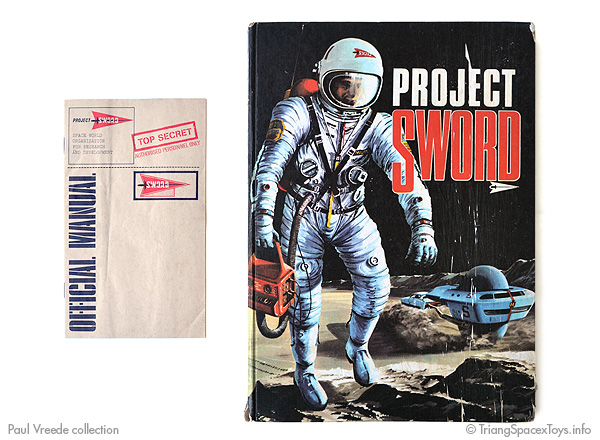
The Project Sword manual and annual
As mentioned elsewhere on this site, the Project Sword range of toys came about when Century 21 Toys
bought up a Hong Kong toy factory. We sadly don't know which factory, or which particular toys it made, but a number
of them did provide the base for the Sword series.
At Century 21 a storyline was invented to suit the various vehicles,
telling a tale of space exploration against a background of a dying Earth. Mankind being in trouble, it was up to
the Space World Organisation for Research and Development to evacuate valuable people to the Moon. Because not all Mankind could be saved, the story
involves many a bloody conflict between Sword operatives and rebelling "casuals" (1).
With such an ambitious objective, it appears the range of vehicles needed reinforcement. Or perhaps
Jack Rosenthal had found some very some nice space toys in Hong Kong that would both fit into the storyline and provide further
opportunities to turn a profit. At any rate, a number of toys mostly based on contemporary space engineering proposals and projects
were added to the Sword line-up. For two of these there's proof they were manufactured by Tai-Hing, while another couple may have also
been sourced from that company. And who knows, perhaps another few toys may have been brought in from yet other manufacturers as well.
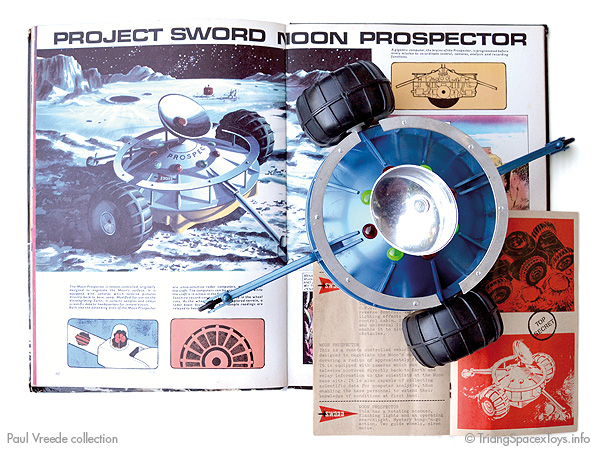
As described elsewhere, the Sword stories were published as comic strips and illustrated text stories, initially
in Solo magazine from June 1967 (2) as well as in TV21 magazine and in an annual a year later (a few of these are included in the Origins
section and linked below). Every toy came with a pin badge (also included in the
Origins section - use your browser's Back button to return here) as
well as a manual - the latter actually being a simple but nicely-done product catalogue.
Eventually almost the entire Project Sword series would also make it to the US, distributed by Tarheel Industries in new boxes and with
a few of the toys having differently-coloured components.
Note: all external links open in new windows
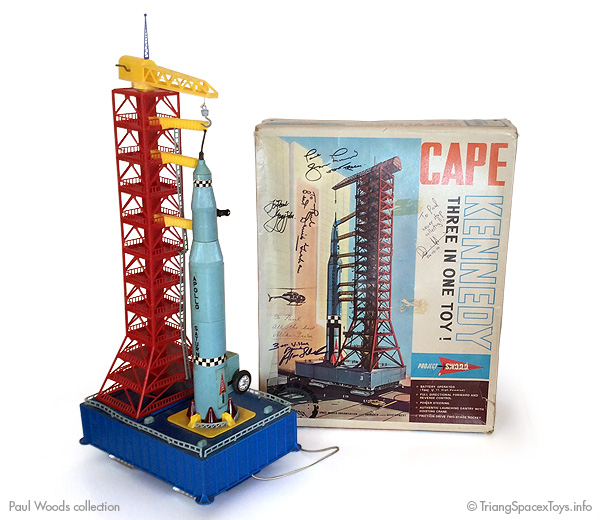
Cape Kennedy Set
This gorgeous toy has a platform powered by remote control (one of two different battery boxes, not shown in image, with a power lead running to the toy) and stands an impressive 46.5 cm / 18 5/16 in tall. The Saturn V rocket on wheels is friction-powered. Although contemporary model kits did exist, I believe this toy to be an original design by an unknown manufacturer (there are no markings anywhere on the toy) based on the real thing, which had come into service in 1967 and was widely publicised as well. The box art is copied from a painting by Robert McCall as featured in Life magazine in 1964. As a note, Paul Woods had the box of his example signed by various Century 21 veterans.
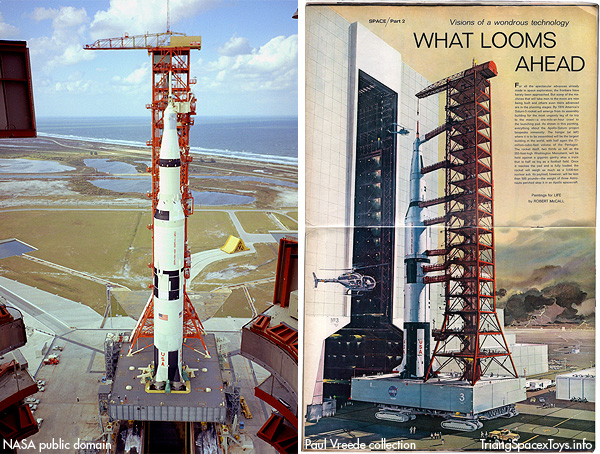
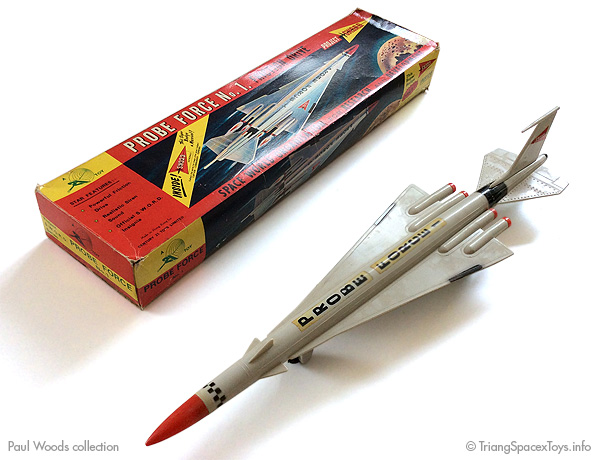
Probe Force No 1
Featuring friction drive with a 'siren sound', this craft is 45 cm / 17 3/4 in long. Only marked 'Made in Hong Kong', its design appears to be based on a cross between the Boeing 2707-300 SST concept and a Nike Hercules missile.

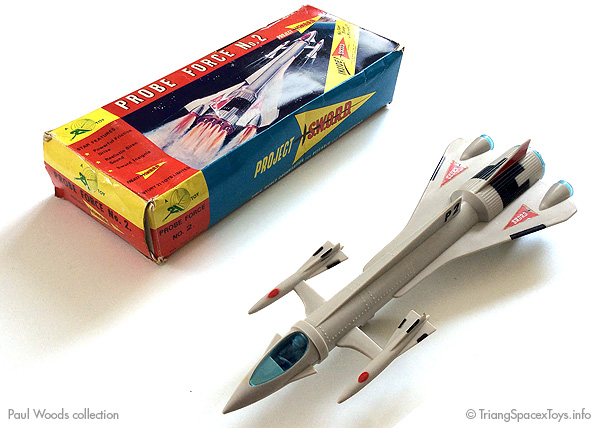
Probe Force No 2
Measuring 31 cm / 12 3/16 in long, this ship also features friction drive with a 'siren sound' and is marked 'Made in Hong Kong' underneath. The fuselage appears to've been copied from a previously existing toy called Apollo Rocket made by Scientific Toys Ltd (it appears in an advert by that company in a Hong Kong trade magazine).
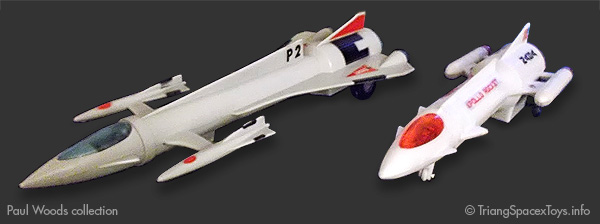
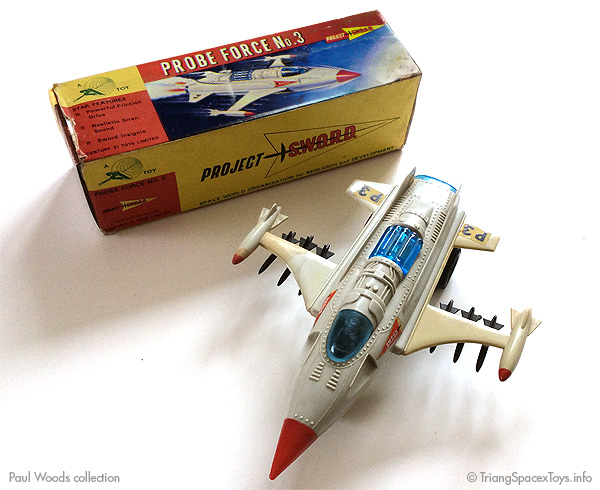
Probe Force No 3
The smallest Probe Force craft is 23.5 cm / 9 1/4 in long, bears no markings of any kind, and is also powered by a 'siren' friction motor. Paul Woods has traced its origins via the JR21 Rocket XL9 (use link on that page to return here) to the Monster racing car design by Otaki of Japan (which he subsequently managed to date to 1965). Andrew Cook has provided pictures of his Probe Force 3 fleet for Paul's blog including an identical XL9 (the ship with red fins below, missing the top fin) and Probe Force 3 sold by Hoover as well as a yellow over purple version by Century 21. The toy was later copied by YT of Japan.
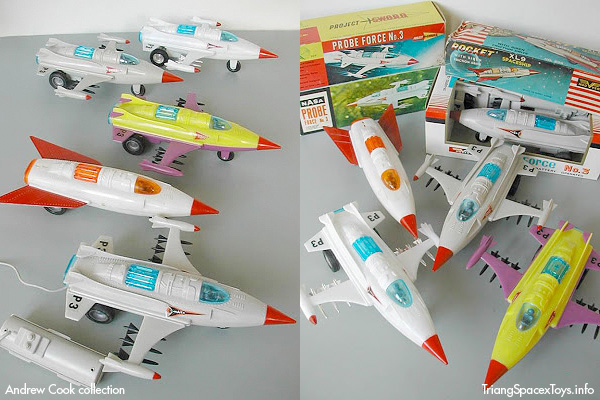
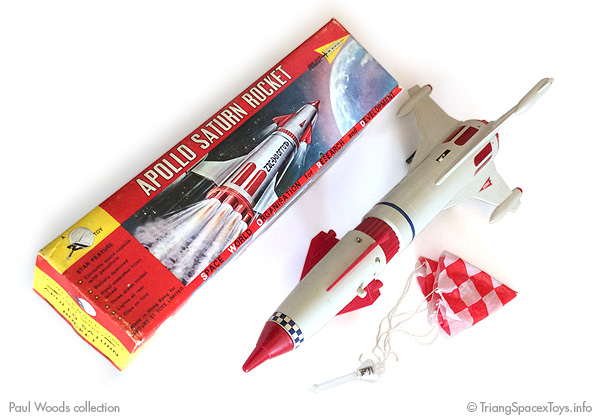
Apollo-Saturn Rocket
An Apollo-Saturn in name only, this battery-powered rocket is 43.5 cm / 17 1/8 in long. It features three separate stages and flashing lights at the rear, while a little capsule can be ejected to land by parachute. It is marked with a Century 21 trademark saying 'A 21 Toy' together with 'Century 21 Toys Ltd Made in Hong Kong'. Design-wise it's a slightly smaller copy of two other rockets, respectively made by Tomy in Japan (below, centre) and for Sears' Turnpike Line (below left).
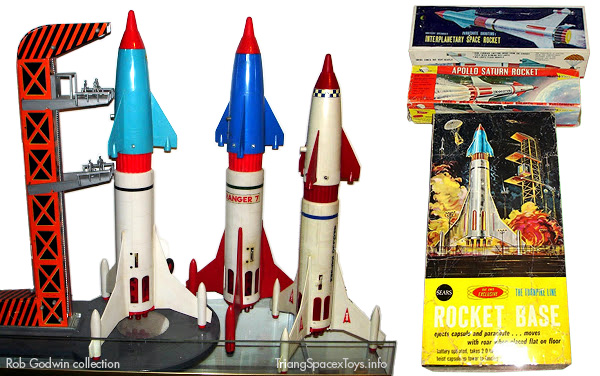
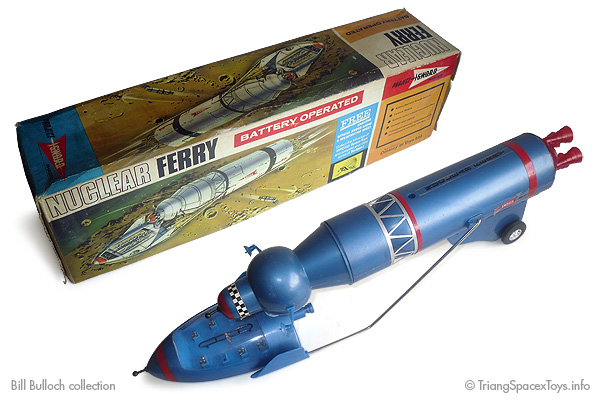
Nuclear Ferry
This beautiful remote-controlled toy is a good 46 cm/ 18 1/8 in long and is based on a painting by Robert McCall (as is the box illustration) of a design proposal by Ling-Temco-Vought. Because it subsequently served as the inspiration for a Spacex toy, there's more in the Origins section (use your browser's Back button to return here).
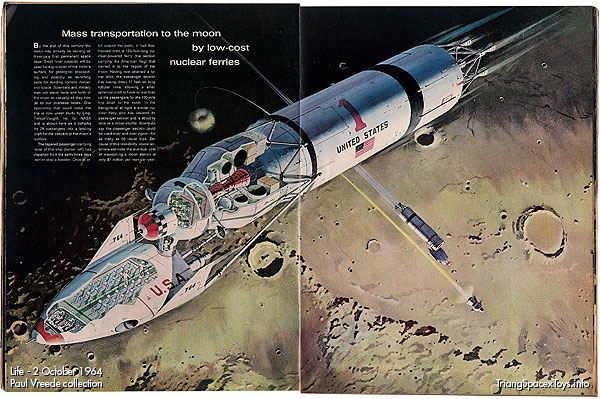
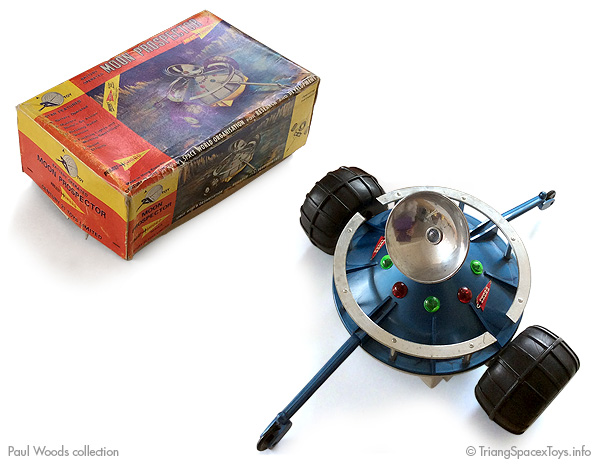
Moon Prospector
With flashing lights and a rotating antenna on top, this battery-powered toy also features 'bump-n-go' action making it reverse and turn away from any obstacles in its path. It's 33 cm / 13 in long and carries the Century 21 trademark for the version sold by that company, and the T-in-a-circle trademark of its manufacturer Tai Hing when originally sold by that company and also on the Sword vehicle sold by Tarheel in the US. As is shown in the Spacex Origins section, it's based on a real-life project for an autonomously moving moon laboratory (use your browser's Back button to return here).
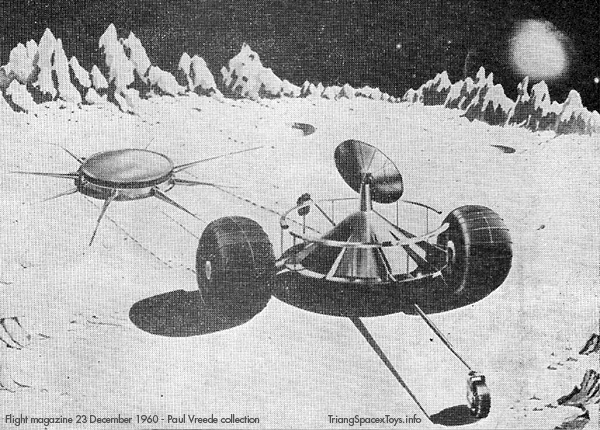
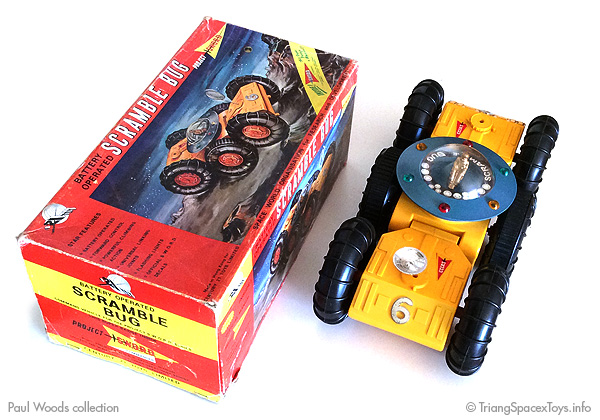
Scramble Bug
Consisting of three linked parts, this battery-powered vehicle has flashing lights and
measures 29 cm / 11 7/16 in in length. It is marked with a JR diamond trademark and 'no. 6' which
makes it fit into the numbers range of the similarly-marked Thunderbirds toys (see that page in
this section). The same vehicle subsequently appeared as a paper kit (see below), a small knock-off
by Hover,
a tiny version in various moon base kits by Otaki and in die-cast by Eidai.
A convincing origin for the design of this toy hasn't been found yet; the closest I've come across
in principle is the SLRV test vehicle below, by the GM Defense Research Laboratories of 1962-4 which
has three wheeled modules coupled by an arrangement that allows the modules to swivel not only
horizontally but also vertically like the Scramble Bug does. The cockpit on top of the toy looks like a
small saucer along the lines of the JR21 Thunderbird 5's hull, while the wheels look remarkably like
an illustration
from as early as 1937 found by Paul Woods.
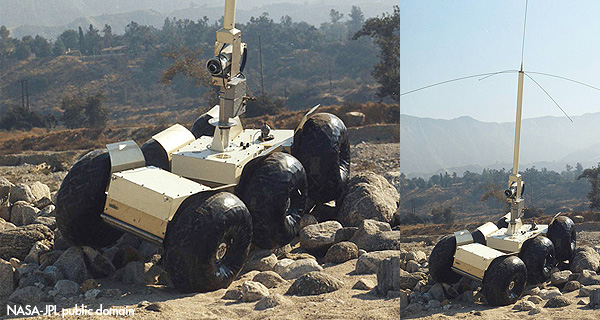
As a note, the Prospector was an earlier programme to deliver an autonomous roving laboratory to the Moon. When that was cancelled, studies continued to see if such a rover could be more cheaply delivered by hitching along with a Surveyor lander - hence SLRV for Surveyor Lander Roving Vehicle.
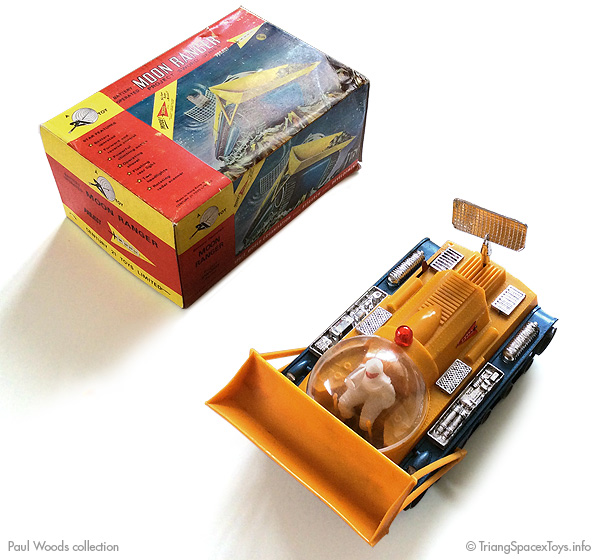
Moon Ranger
Battery-operated with working lights and revolving radar, this toy is 23 cm / 9 1/16 in long and marked ’Made in Hong Kong’. Its design is based on a couple of model kit vehicles by Nichimo of Japan, from 1963 and 1965 respectively, which Will "Rocket Punch" Schwartz found in a Japanese magazine on vintage model kits.
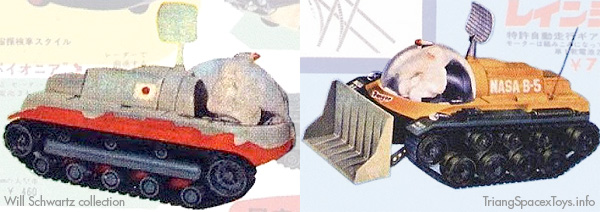
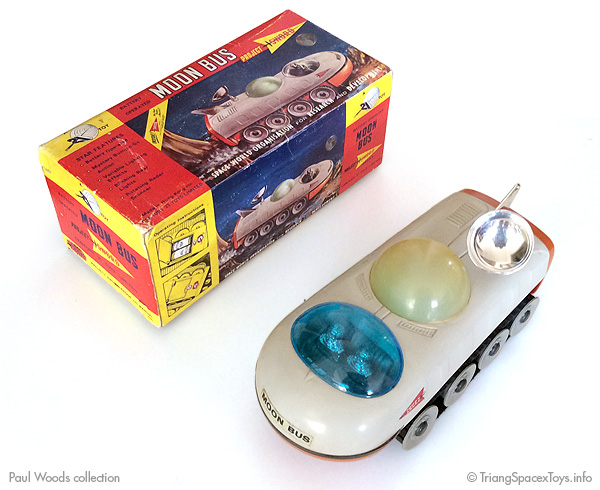
Moon Bus
Another toy produced by Tai Hing, but marked with the Century 21 trademark and 'made in Hong Kong', this vehicle is 23.8 cm / 9 3/8 in long and battery-powered with flashing lights. The Moon Bus is one of three toys based on an illustration by I. Teece (below). Since its design influenced a Spacex toy, there's more in the Origins section (use your browser's Back button to return here).
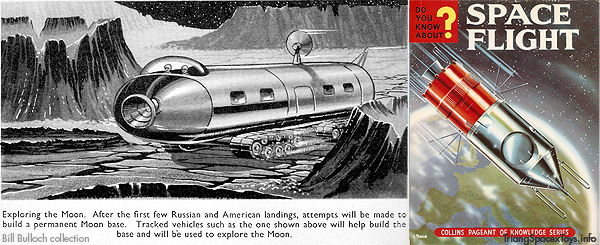
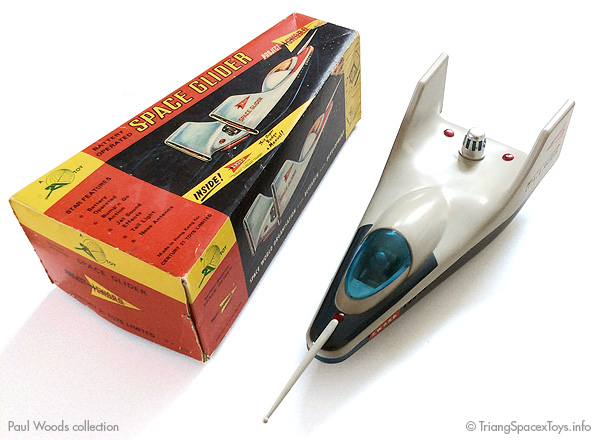
Space Glider
Marked with the JR diamond trademark, this toy is based on the Northrop M2-F2 lifting body. It's 36 cm / 14 3/16 in long (including the nose antenna) and was also sold by other brands in various shades of grey as well as orange and even green. Battery-powered, it also features bump'n'go action and flashing lights at the rear. More on the M2-F2 in the Origins section (use your browser's Back button to return here).
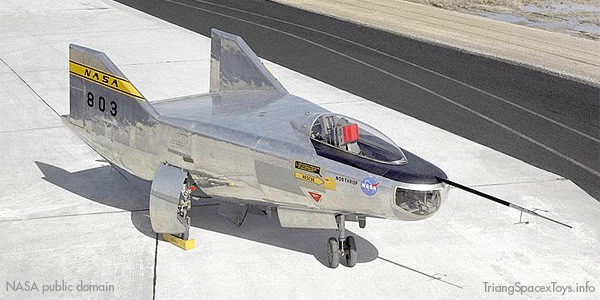
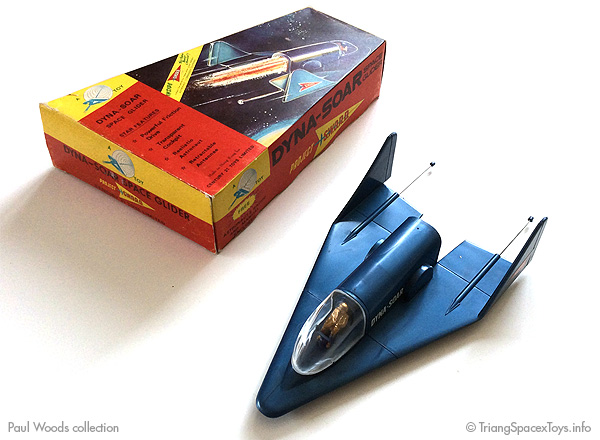
Dyna Soar Glider
This attractive toy is modeled on the X-20 Dyna Soar glider, which was intended to be launched atop a missile by the USAF but got cancelled due to cost - NASA has more details and photos. The toy features friction drive and retractable rear antennas, is 20 cm / 7 7/8 in long and marked with the JR diamond trademark and the number 202.
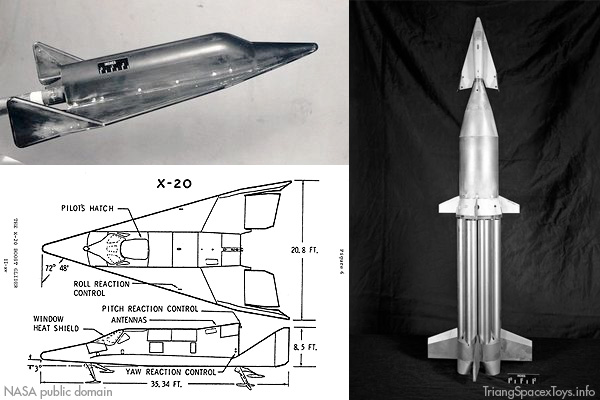
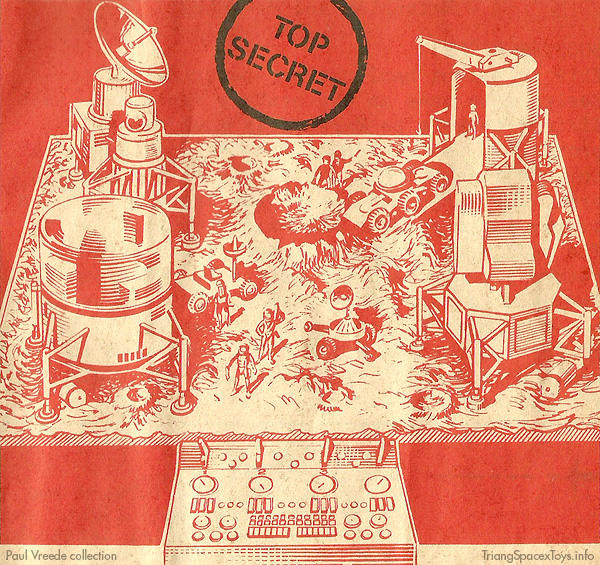
Moon Base
The Project Sword Moon Base is a total mystery. It's included in the Sword manual, but none have ever been seen, and the manual also doesn't mention its size. Its design is very much like a base illustrated by Ed Valigursky for the Man and Space book published by Life in 1962. And the astronaut figures illustrated with the Sword base have poses that unmistakably identify them as by LP (use your browser's Back button to return here).
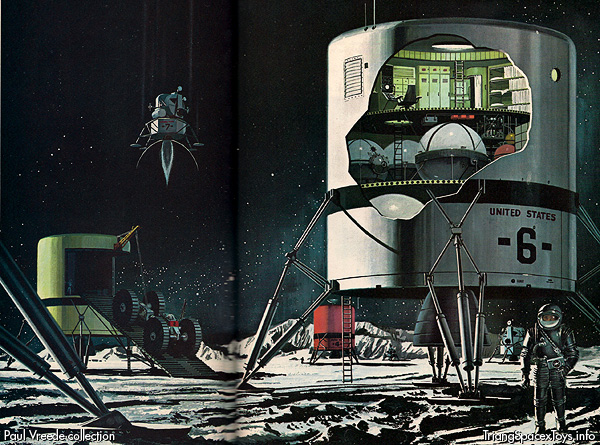
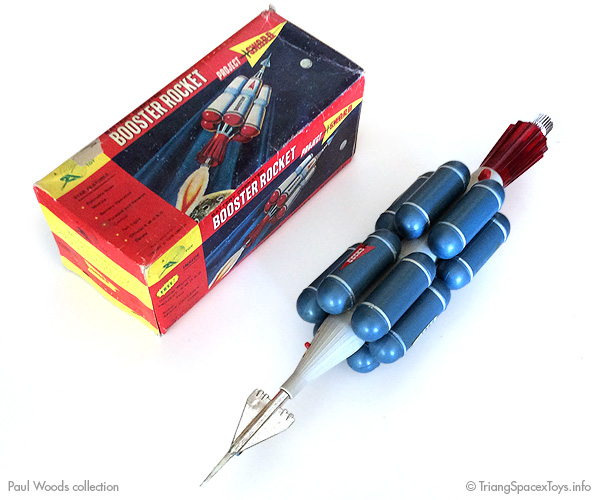
Booster Rocket
Another toy that's clearly based on a Valigursky painting (incl the box illustration), the Booster Rocket originally was a project by General Electric for reaching Mars. The toy is battery-operated with flashing lights at the rear, while the front shuttle can be ejected to roll on its own wheels. Measuring 46 cm / 18 1/8 in in overall length, the toy is only marked 'Made in Hong Kong'. More in the Origins section (use your browser's Back button to return here).
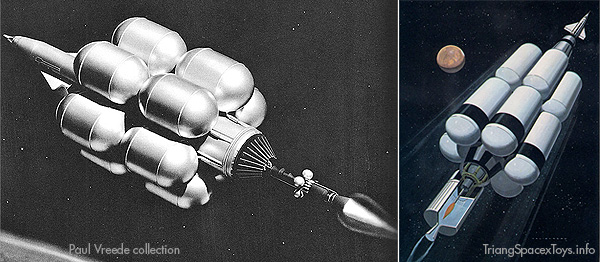
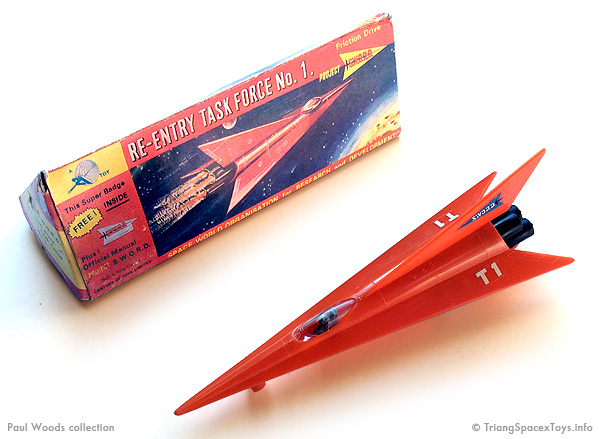
Re-Entry Task Force No 1
This very clean design has friction drive and is 20.5 cm / 8 1/16 in long. The subsequent Tarheel version has engine exhausts in green, and there are versions in plain plated and metallic blue as well, possibly by the same manufacturer who produced the plated Task Force 3 linked below.
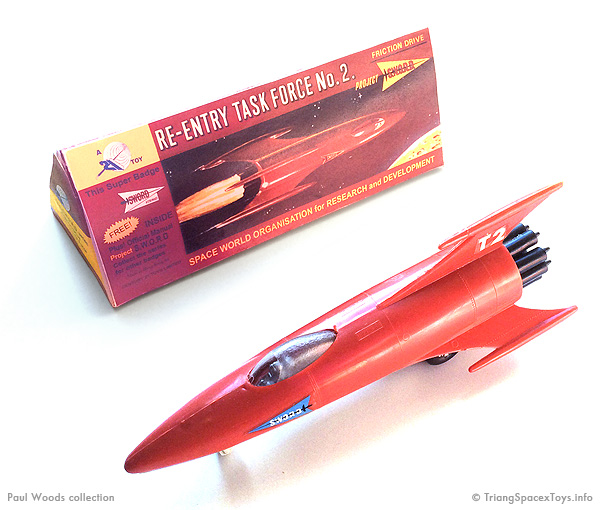
Re-Entry Task Force No 2
Another simple, friction-driven ship with a more traditional shape, measuring 20.5 cm / 8 1/16 in. The newer version by Tarheel has a body moulded in yellow. (note box shown is a reproduction).
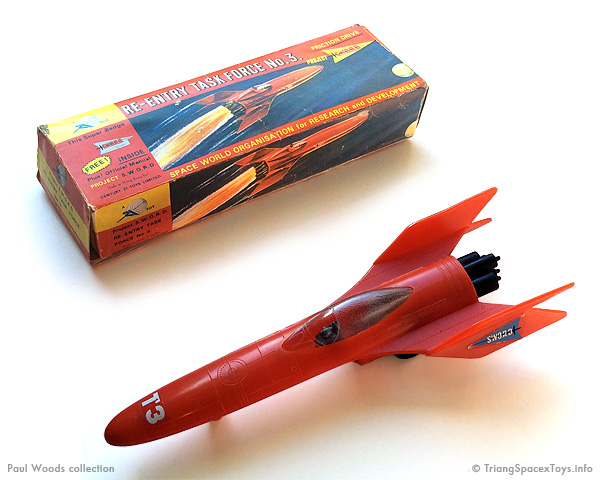
Re-Entry Task Force No 3
This attractive craft is also friction-driven, and is also 20.5 cm / 8 1/16 in long. The subsequent version from Tarheel was moulded in white, as was a version by SL carrying 'Task Force' stickers in a box that also looks much more recent. Much like Task Force 1, a plated version was also made by an unknown manufacturer.
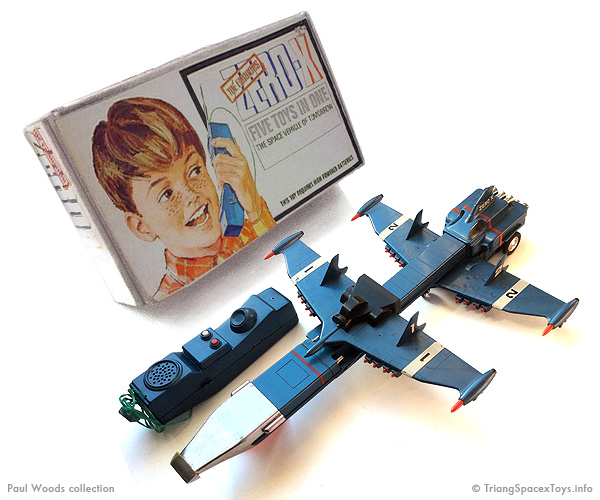
Zero-X
While not really a Sword craft per se, the Zero-X is included at the end of the Project Sword manual as a suggested addition to the reader's fleet, and also was supplied with a Sword 'Supremo' pin badge and manual. Designed by Derek Meddings for the 'Thunderbirds are Go' feature film, the battery-operated toy version is also made up from separate components to be assembled into the full composite craft as per the movie model. It is marked with the JR diamond trademark and 'No.7 Zero X Regd. Design No. 927493 Made in Hong Kong' (the number 7 fitting in with the Thunderbirds range of ref. numbers) and overall measures 47 cm / 18 1/2 in long. Moonbase Central has a blog post with photos of the 'real' Zero-X from the Mastermodels company who built it to Meddings' design drawings.
Not shown in the manual are the following later additions to the series:
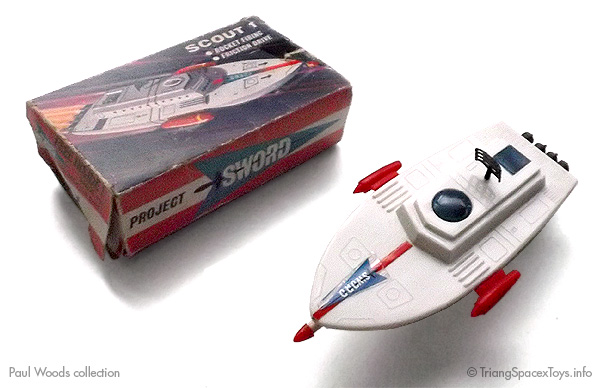
Scout 1
Intended to represent an amphibious ship, this toy features friction drive and a missile shooting from the prow. It is 14.5 cm / 5 3/4 in long, and is based on the Seabug craft from a Fireball XL-5 story by Mike Noble appearing in TV21 #68 of 7 May 1966.
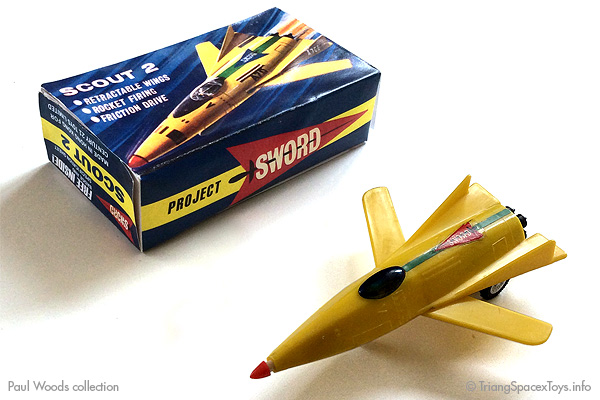
Scout 2
Featuring friction drive, retractable wings and firing a rocket from the nose, this neat little craft has a length of 14.5 cm / 5 3/4 in but carries no markings of any kind (Note the box shown is a reproduction). Bill Bulloch discovered a lifting body shape that bears a very close resemblance, and had previously also appeared in an article in TV21 magazine of 21 January 1967 (below left). Paul Woods then found that same shape in an overview diagram of various lifting body configurations, which I eventually managed to trace back to a USAF hypersonic glider project from 1966. The shapes turn out to be models (by various contractors) for windtunnel tests conducted at the AF Flight Dynamics Laboratory by a team led by Alfred Draper, who, much later, wrote a full recapitulative report on it. The overview below is from p42 of that pdf, which shows this work ended up determining the shape of the very successful Martin Marietta X-24B.
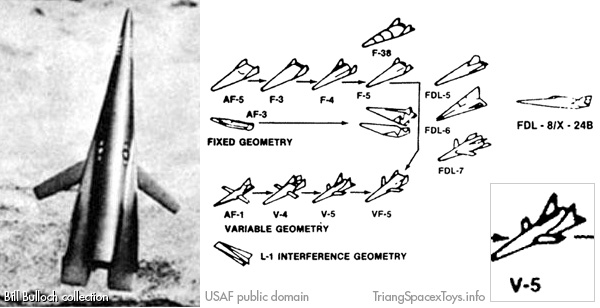
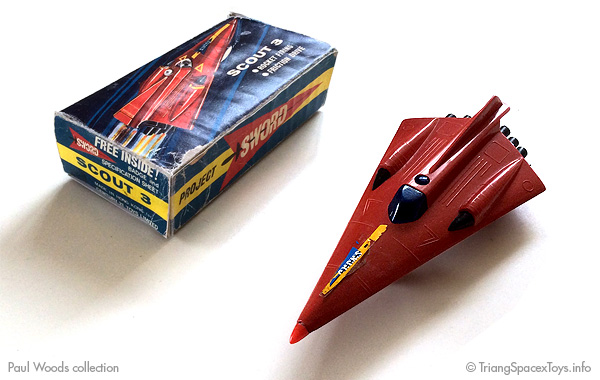
Scout 3
Also shooting a missile from the nose and friction-driven, this toy is 15 cm / 5 15/16 in long and also unmarked. Although showing authentic wear and tear, the box shown is a reproduction.
And to be complete, two paper kits were also produced by Century 21 Books:
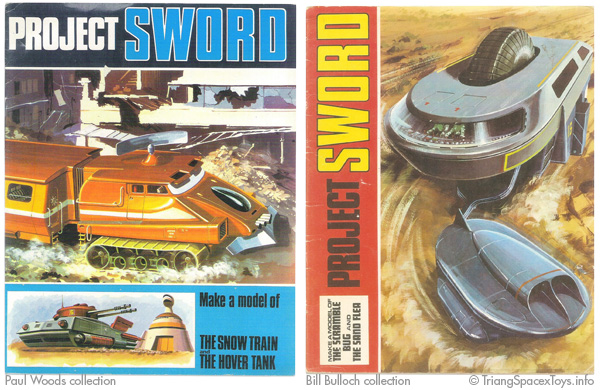
Both books contain an illustrated Project Sword story and two kits. SW1 at left has the Snow Train and Hover Tank; SW2 contains the Sand Flea and Scramble Bug.
Bill Bulloch wrote a
blog piece
which includes pictures of three of these models built by Joe Murray, as well as a page from the
TV21 Summer Extra issue of 1966 illustrated by Eric Eden which includes his Snow Train and Sand Flea
on which these paper kits are based. Paul Woods has provided
scans
of the entire first kit book should you want to read it or even download and build the models in it.
The Hover Tank was originally intended to be a plastic toy, as is evident from a
registered design document I found.
(use your browser's Back button to return here)
1: The Project Sword back story is concisely included in the paper kit book shown above, should
you want to read it: page 1 and top of
page 2.
back to text
2: The more extensive introduction of both toys and story as published in Solo #19 of 24 June 1967 can be seen and read on
Moonbase Central.
back to text